[ad_1]
Stuck in a rut trying to figure out what to post on LinkedIn?
You might be thinking, “I need a list of post ideas!”
But what’s more important than a list of post ideas? Having solid SOURCES that give you an infinite amount of ideas.
After all, it’s not easy to develop ideas that keep people interested in what you’re saying (and keep them coming back for more).
Fortunately, some straightforward sources can help get the creative juices flowing and ensure that EVERY post is engaging and optimized for success.
In this blog post, we’ll look at 17 places to look when creating content on LinkedIn so that you can start building an engaged audience of followers who will love interacting with your posts!
We’ll even show you how to use a LinkedIn tool that makes finding content easier than ever.
Feel free to skip to the section you’re most interested in:
Why posting on LinkedIn is a struggle
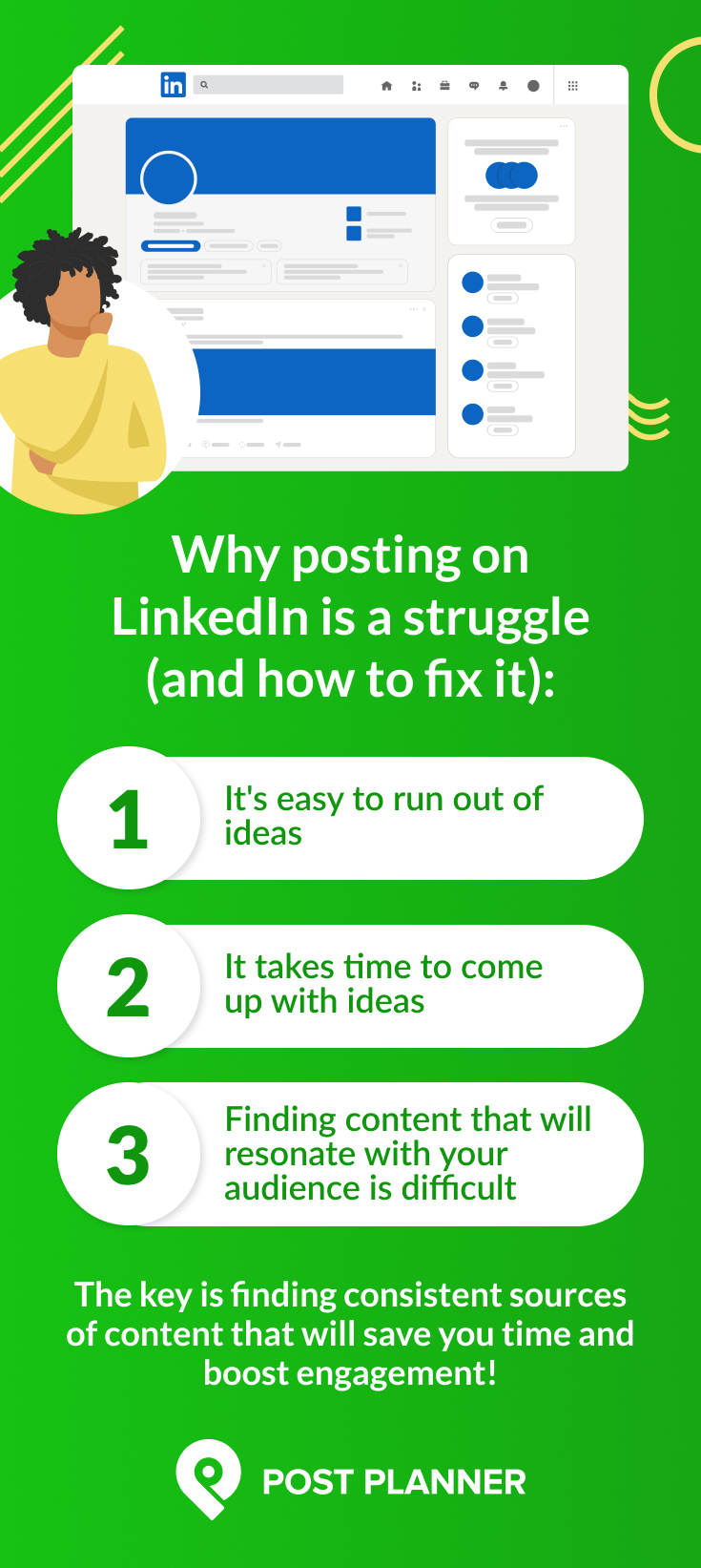
LinkedIn is an excellent platform for professionals to connect, share, and grow in their industry. But there’s one significant struggle that plagues every professional on LinkedIn:
Maintaining a consistent posting schedule
It’s not as easy as just logging into LinkedIn and making a post (unfortunately!). There’s a lot that goes into a great LinkedIn post:
- The content has to resonate with your audience
- It can’t be the same thing over and over again
- It needs to be well thought out and extremely high-quality
This leaves many feeling overwhelmed and unsure of where to go next.
Let’s look at some main reasons people struggle to pump out high-quality LinkedIn content regularly. Then, we’ll start looking at how to overcome those struggles.
Struggle #1: It’s easy to run out of ideas
Have you ever sat down at your computer to post on LinkedIn and thought:
“Well, shoot. I don’t actually know what I should post.”
Yeah, me too.
In fact, EVERY LinkedIn marketer has done this because it’s so hard to come up with fresh ideas day in and day out.
This is what causes businesses to get stuck in those ruts where they’re constantly posting content that’s almost identical to what they posted the day before (and the day before, and the day before, and so on).
Struggle #2: It takes a lot of time to constantly think of ideas
Developing ideas and creating content that will engage your audience can be time-consuming.
Many people solve this problem by simply choosing not to post very frequently.
And it’s hard to blame them! After all, if you want to be successful on LinkedIn, you need to post at least 3-5 times a week without becoming repetitive.
People run out of ideas and don’t have time to sit down and create an excellent post every day.
To beat this problem, you’ll need a quick solution to find excellent content (more on that later).
Struggle #3: Posting content that’ll resonate with your audience is hard
Knowing what will resonate with your audience can be tricky.
Sometimes, it seems like they’ll love a post you worked hard on, and it falls flat. Other times, a seemingly pointless throwaway post will get engagement galore.
In other words, people can be hard to predict, which makes it hard to find and post content that’ll resonate with your audience.
Again, the solution to this problem is finding reliable sources that generate content you KNOW will resonate with your audience.
Since it’s evident that finding content sources is the key to revolutionizing your LinkedIn presence, let’s talk about how to do just that.
What to post on LinkedIn: Focus on these 17 sources to find unlimited LinkedIn content ideas
LinkedIn’s algorithm is more likely to recommend your content if people regularly engage with it. But you’re more likely to get regular engagement if you post consistently.
In other words, getting your content seen means posting A LOT.
And posting a lot means that you need to have FOOLPROOF sources of LinkedIn content where you can go and find a slam dunk post in record time.
But does a source like that exist?
Yes. In fact, there are lots of them.
In this section, we’ll look at 17 fantastic content sources to boost your LinkedIn engagement.
1. Customer stories
Your customers are the lifeblood of your business, and your audience wants to know their stories.
Ask them questions, and get to know their pain points. Turn their answers into case studies, testimonials, and other content that shows how happy your customers are with their decision to purchase from you.
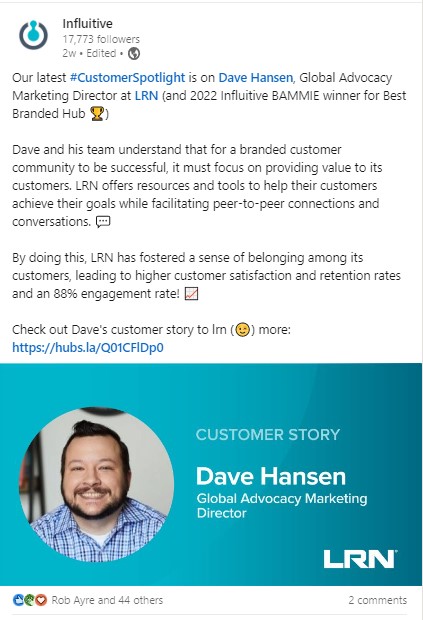
After generating some of these customer stories, space them out weekly or bi-weekly to give your audience a steady dose of them over time.
2. Read customer reviews
Customer reviews are a goldmine of valuable content ideas because your current customers are TELLING potential customers how great your business is.
Check out comments left on your website or other review sites to see what people say about your product or service.
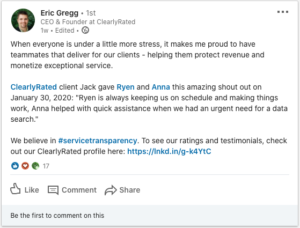
Then, use this feedback to craft posts that address common concerns. Make sure to include an image of the original review to add a level of authenticity.
3. Listen to recorded sales calls
The more sales you make, the better you understand your customers’ needs and wants.
Reviewing your recorded sales calls can provide valuable insights into your customers’ language and the types of problems they’re trying to solve.
For example, you might frequently hear similar comments from customers:
- They need a product that saves them time.
- They need indispensable information/data.
- They want to save money.
Use this information as a source for posts that address these issues and show your audience what your product offers.
4. Look at notes in your CRM
Your CRM is a treasure trove of valuable information about your customers (if you’re using it right).
Look at the notes left by your sales team, customer support, or account managers to see the topics most important to your customers.
For example, you might see that your sales team regularly notes that people ask why your price is higher or lower than your competitors’ price. That clues you into the fact that people are interested in understanding your pricing model better.
Turn the insights you get from those notes into LinkedIn posts, preferably visual content to ensure higher engagement.
5. Repurpose content from your other social media accounts
If you’ve already created content for different social media channels, don’t let it go to waste!
Repurpose it for LinkedIn!
There are several ways to do this:
- Pull out key quotes from longer posts
- Use your existing content as inspiration for new posts
- Repost the same thing from your other accounts if it doesn’t need any changes
- Take shorter content from Instagram or Twitter and expand on it
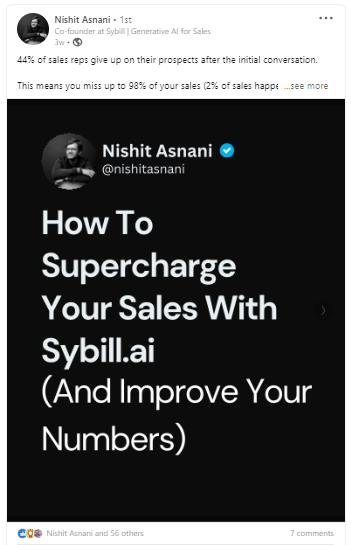
The key here is to get creative while saving time by reusing the bones of your preexisting social content.
6. Repurpose or reuse posts that are 6+ months old
Do you have a post that killed it on your LinkedIn last year (or more recently)?
If you’ve consistently posted on LinkedIn for a while, you may have older posts that still resonate with your audience.
This is especially true if your business goes through seasons (most do). For example, a coffee shop sells more iced coffee in the summer and hot coffee in the winter. They would want to repurpose their summer content in the summer and winter content in the winter.
Repurpose or update these old posts and share them again on your profile.
If they worked once, they’ll work again!
7. Industry news
Sharing news about your industry can position you as a thought leader and keep your audience informed on the latest trends.
Industry news is a never-ending source of content. Take the most recent headlines from your industry and give your expert opinion on what’s happening. It doesn’t take nearly as long as coming up with something from scratch, and it’s still a great source.
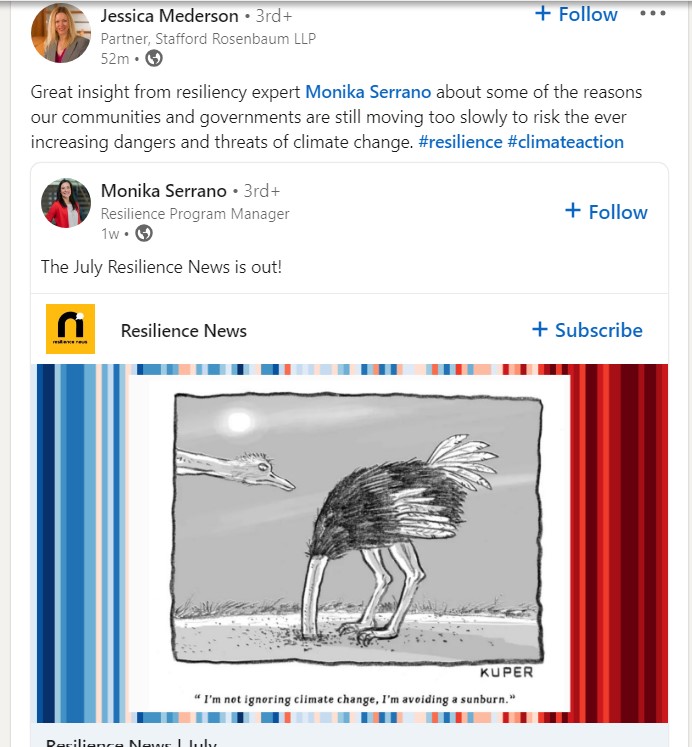
Use the following sources to stay up to date in your field:
- Industry blogs
- News outlets
- Thought leaders
- Influencers
8. Repurpose podcasts and long-form videos into short clips
LinkedIn is more likely to recommend shorter content to your audience than longer content.
That means that your 45-minute podcast won’t do well on LinkedIn. However, that doesn’t mean you can’t use PARTS of it.
If you have long-form content (like podcasts or videos), break them into shorter clips and share them on LinkedIn. For example, you might take a 30-second clip of your main point and turn it into an engaging LinkedIn video.
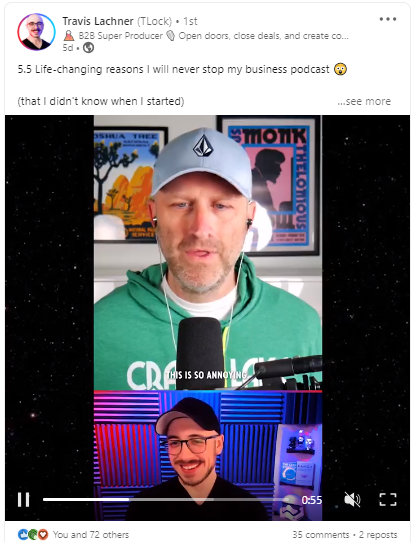
You can chop a 45-minute podcast into dozens of these soundbites and produce a ton of content for your page.
This can help you reach a wider audience who may not have time to listen to or watch longer content.
9. Repurpose blog posts
If you have a blog, don’t let your old posts collect dust! They could pull double (or triple, or quadruple…) the engagement on LinkedIn!
Repurpose them for LinkedIn by creating shorter versions, or sharing snippets.
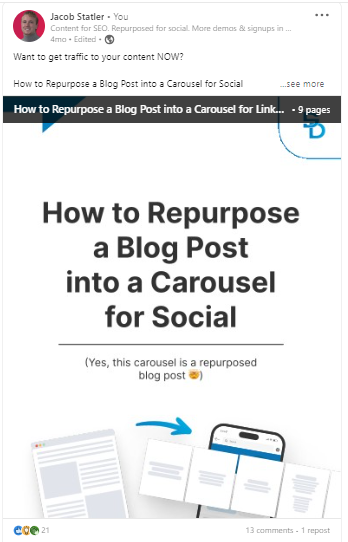
Similar to what you did with your podcasts and videos, you can chop these longer blog posts into:
- Shorter text-based posts
- Carousels
- Short videos (using your blog post as a script)
10. Interview industry influencers and experts
Want some extremely high-yield content?
Reach out to influencers or well-known experts in your industry and conduct an interview.
Picking their brains can provide valuable insights for your audience and help you build your network. Having an influencer’s name on your content is likely to generate much higher engagement than your regular posts.
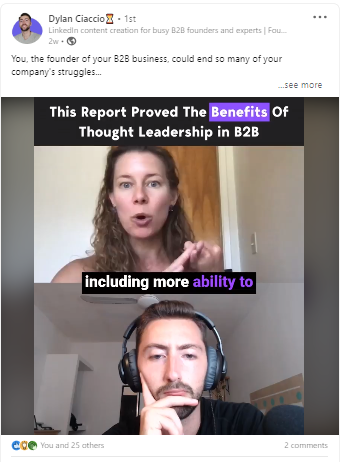
You can also break the interview into bite-size snippets to maximize the content you get from a single interview.
For example, post the whole interview on your podcasting platforms and YouTube, then break it up into a dozen posts for your LinkedIn!
11. Post user-generated content (UGC)
User-generated content (UGC) is any content your customers produce related to your product or service, and it’s highly valuable for your business.
In fact, using UGC as marketing content results in 29% higher web conversions.
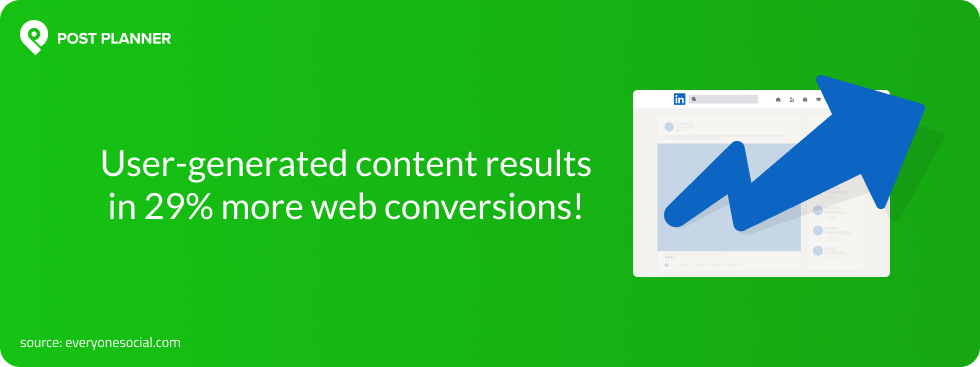
When you find examples of UGC related to your business, ask if they would be willing to let you share their posts with your other followers on LinkedIn!
For example:
- A satisfied customer might post a picture using your product
- They might mention you in a blog post or a YouTube video
- An unboxing video or how-to tutorial
All of these are examples of UGC, and they are just waiting to be turned into content for your LinkedIn!
12. Networking events
Networking events can be a great way to meet people in your industry. However, they’re also a fantastic opportunity to learn about new trends or topics in your business’s niche.
There are so many excellent ways to get content for your LinkedIn pages at these networking events:
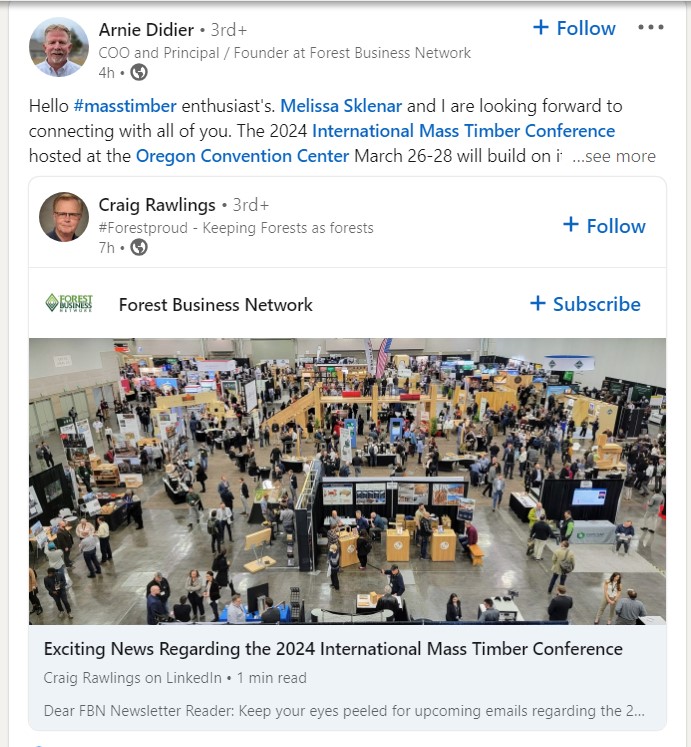
- Film shorts of yourself talking with industry leaders
- Show cool new developments and talk about them with your followers
- Gain inspiration for new trends and post about them
- Create round-up posts of your learnings from the event
Take advantage of these events by sharing your experience on LinkedIn.
You’ll quickly see your followers engaging with you on these topics.
13. Lessons learned
As much as we all like to think we’re perfect, we’re (unfortunately) not.
But instead of trying to hide that fact, why not take advantage of the opportunity to reflect on your growth and the lessons you’ve learned?
Share a mistake you made and how you overcame it or a lesson you learned from a difficult experience. This is a quick way to find content without resorting to low-quality posts that nobody cares about.
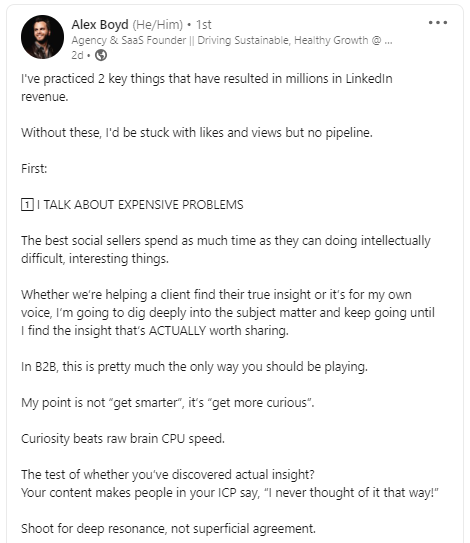
Sharing your own experiences can not only humanize your brand, but it can also provide valuable insights for your audience.
14. Repurpose a meme to relate to your industry
If your LinkedIn is ONLY serious content, you’re probably missing out on a good bit of engagement.
Remember that your LinkedIn marketing isn’t targeting robots! You’re trying to reach human beings, and humans like to laugh and be entertained!
Memes are a fantastic way to engage your audience on social media in a lighthearted way. Plus, people who find your page funny or entertaining are more likely to feel like they relate to your business.
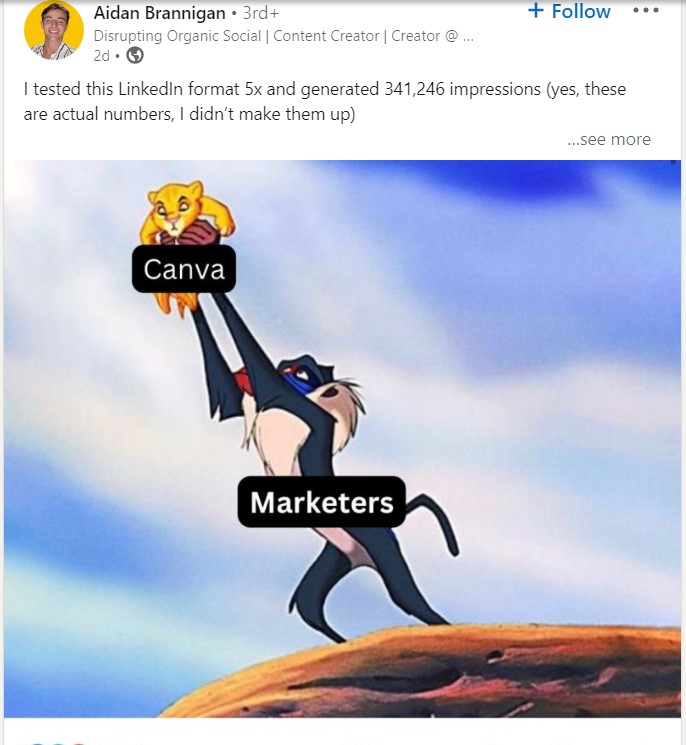
Popular online memes are a great place to find a template to use. Then, just add your industry-specific twist to it. Make it funny, quick, and specific to your niche for the highest impact.
15. Monitor competitors
Your competitors are also trying their best to post engaging LinkedIn content, so why not take a look at what they’re posting for a bit of inspiration?
You should regularly keep an eye on what your competitors are posting. Then, you can “steal” their content and strategy to improve your engagement.
However, you should NEVER copy your competitors directly. Copying them is not only bad taste, but it also doesn’t take the opportunity to IMPROVE on their post. Use their content as a springboard, then create your version or take a different angle.
If you do this correctly, you can improve on your opponents’ content while saving time and improving your engagement!
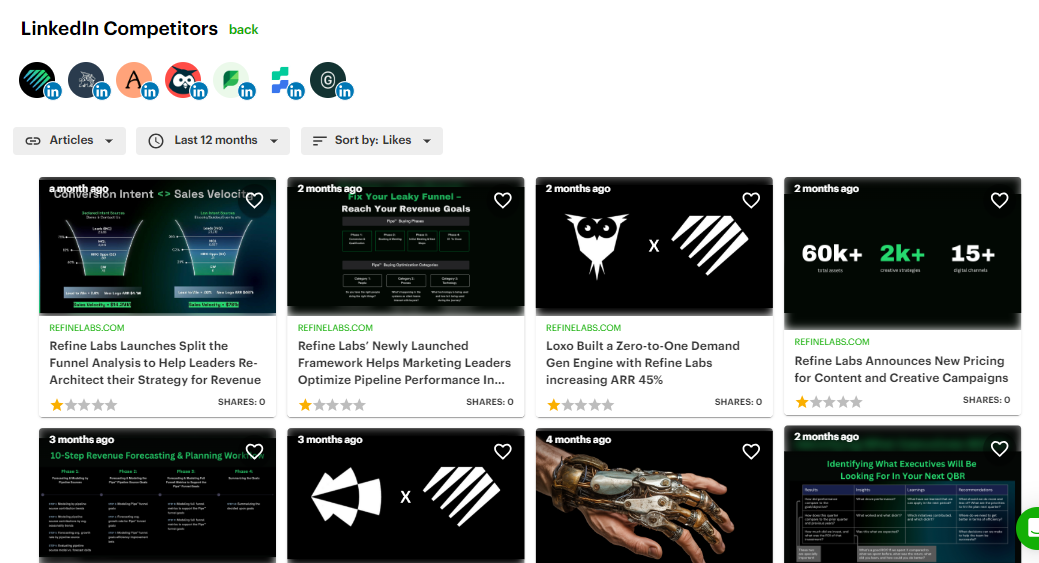
I recommend using Post Planner to create a Content Stream of your top competitors. You can regularly browse the stream when you’re looking for ideas.
16. Proven curated content in your niche
These are all great sources for content, but you probably still need more sources to create a well-rounded content plan.
This is where using a great content curation tool comes into play.
Using a content curation tool like Post Planner can help you find relevant content to share with your audience. It can quickly show you content from around the internet that’s already performing well in your niche, allowing you to save time while improving the quality of your own posts.
For example, here’s a content stream I found of top content marketing influencers:
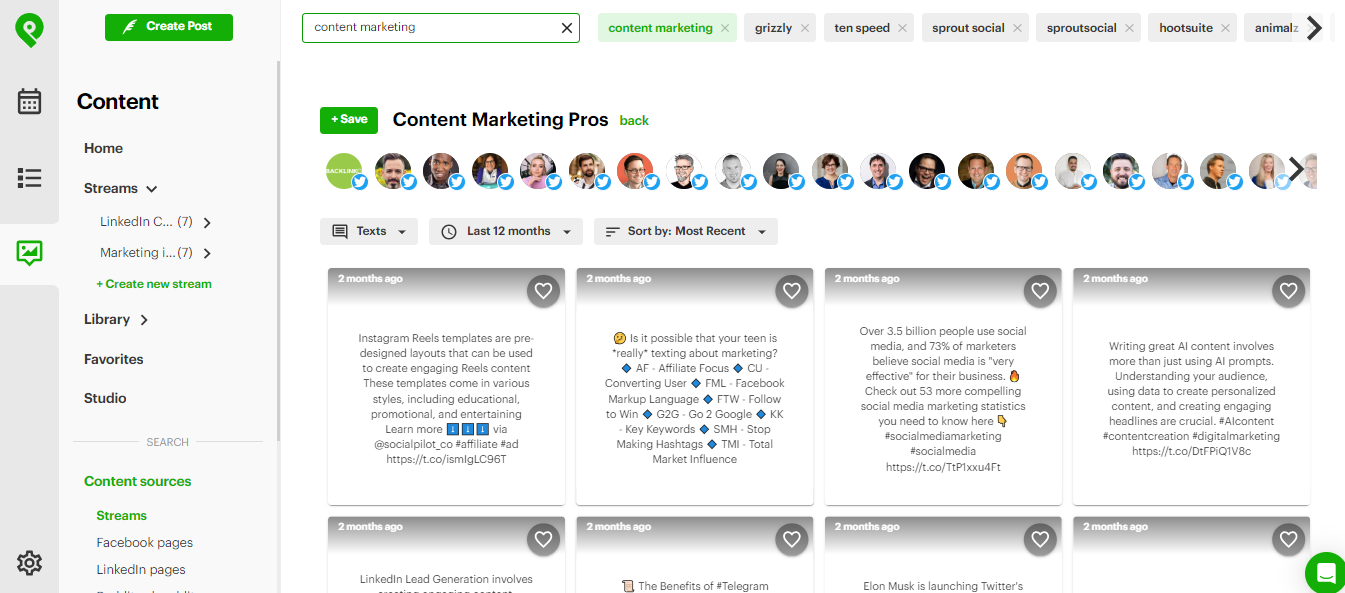
You can also do content curation without a dedicated tool. Just follow a lot of Facebook, Twitter, and Instagram accounts in your niche and keep an eye on what they’re posting. If you think something they post resonates with your audience, try creating your own version of it!
17. Find content and automate your LinkedIn with Post Planner
We briefly mentioned how Post Planner can help you find good content ideas, but now let’s show you HOW.
Consistently finding or creating high-quality content can be time-consuming and difficult.
We’ve already looked at many sources for LinkedIn content, but you might still be wondering how you can QUICKLY get enough content to consistently post every single day (without letting your quality drop).
Fortunately, Post Planner offers content curation and a LinkedIn scheduling tool to make it easy to boost your content production in a fraction of the time.
Here’s how to find content and automate your LinkedIn with Post Planner.
Create a posting plan
First, developing a posting plan is essential to ensure your content is consistent and reaches your audience at optimal times.
With Post Planner, you can create a schedule that aligns with your target audience’s behavior, including the best days and times for posting.
To do this, go to the “Posts” tab, then follow these steps:
- Click “Posting Plan.”
- Select the days you want to post.
- Select the times you want to post.
- Select the Content Buckets (these are the categories you can use to organize your content) you want Post Planner to draw from for each posting time.
- Select the type of content that’ll be eligible to post at each time.
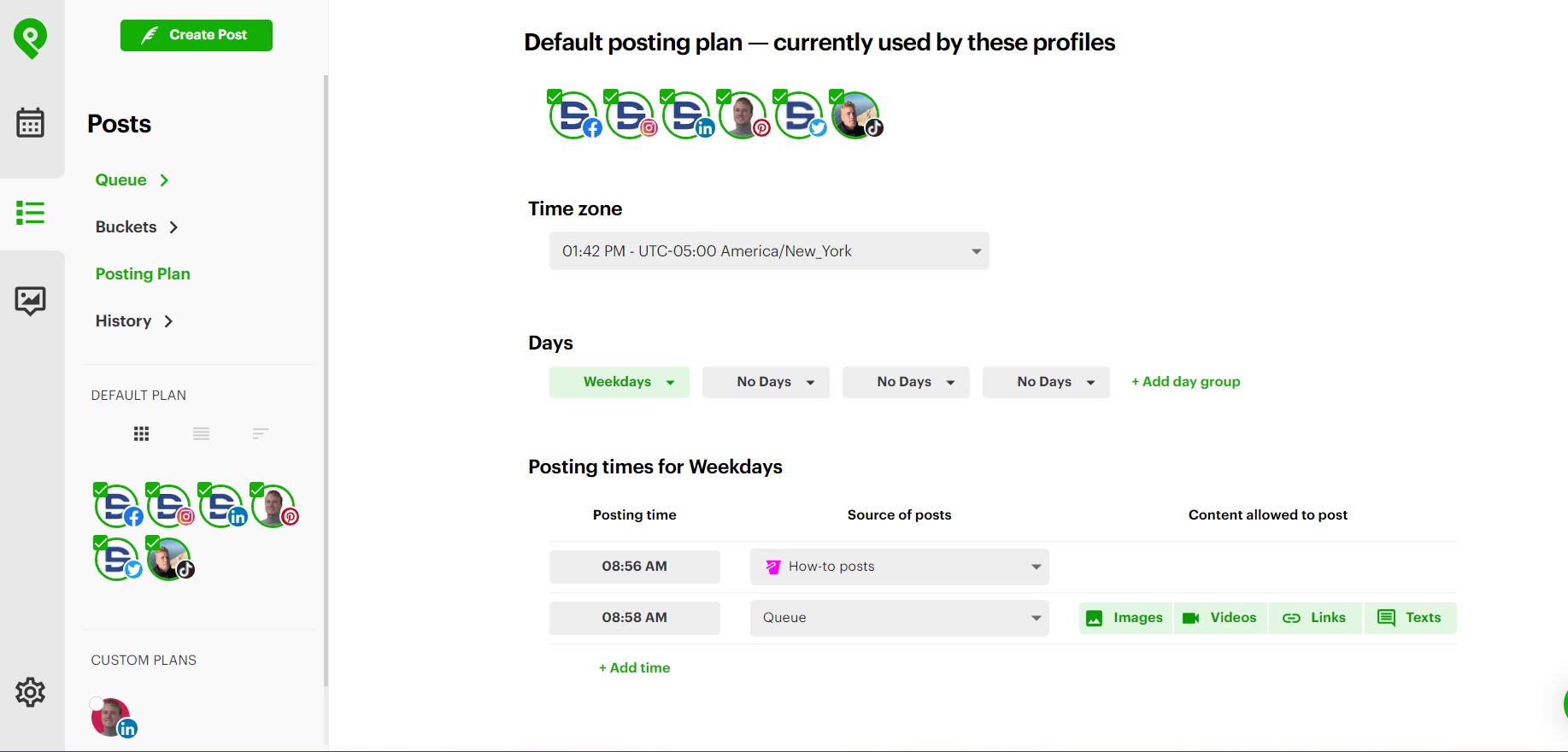
Post Planner will do the rest! It’ll automatically post the right content to the right social media channel at the right time.
This will allow you to maximize engagement with your followers by posting consistently at the correct times. It also helps ensure your content is seen by as many people as possible.
Find and create Content Streams
The next step is to find or create Content Streams, which are collections of content from around the web.
Post Planner offers a variety of pre-made Content Streams that can be easily curated and added to your content plan. Search for the topic you want to post about, then see what Post Planner offers.
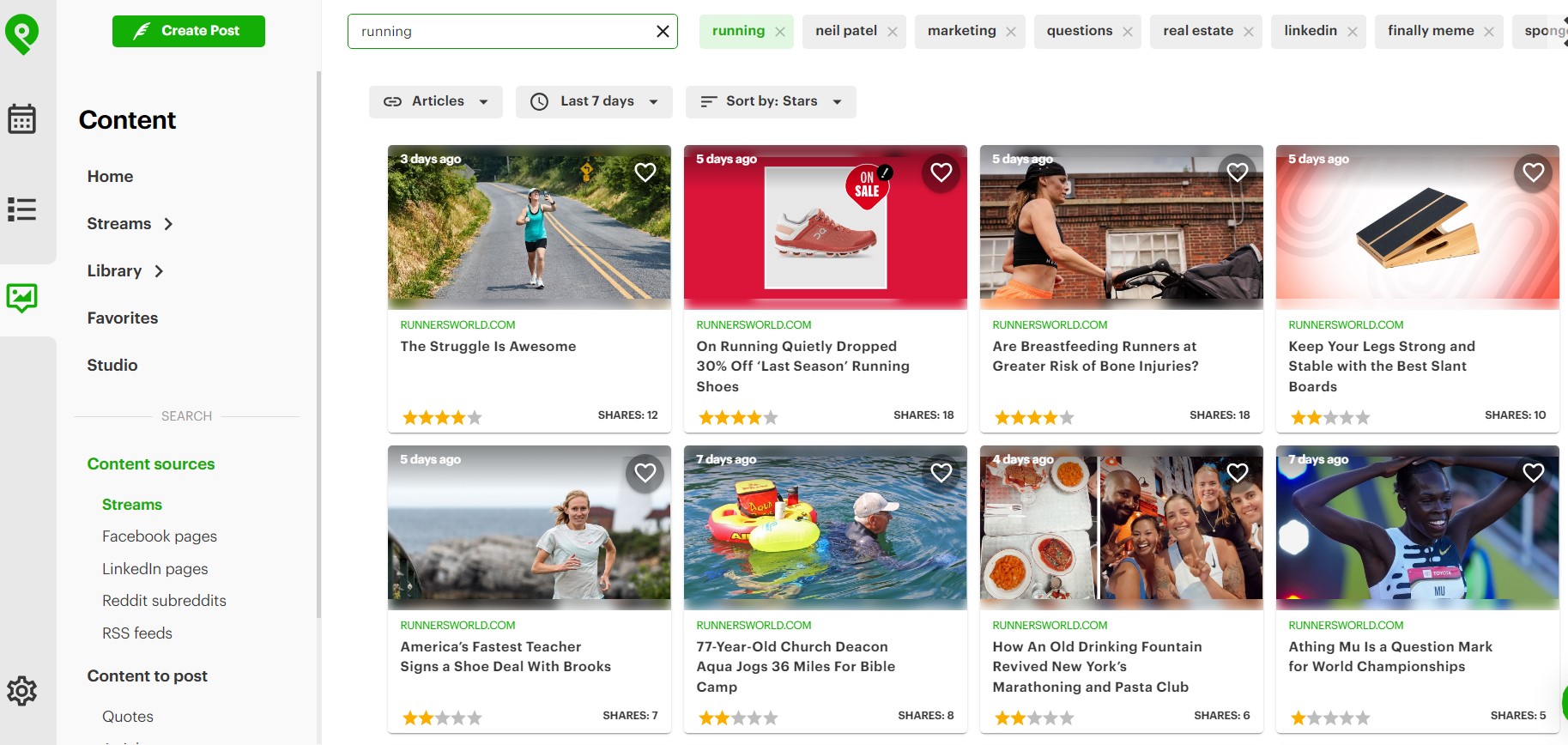
These streams include a mix of articles, videos, and images that are relevant to your industry or interests.
If you can’t find something relevant to you, you can also create your own Content Streams. Select the sources you want to combine into a stream, then click “Save Feed.”
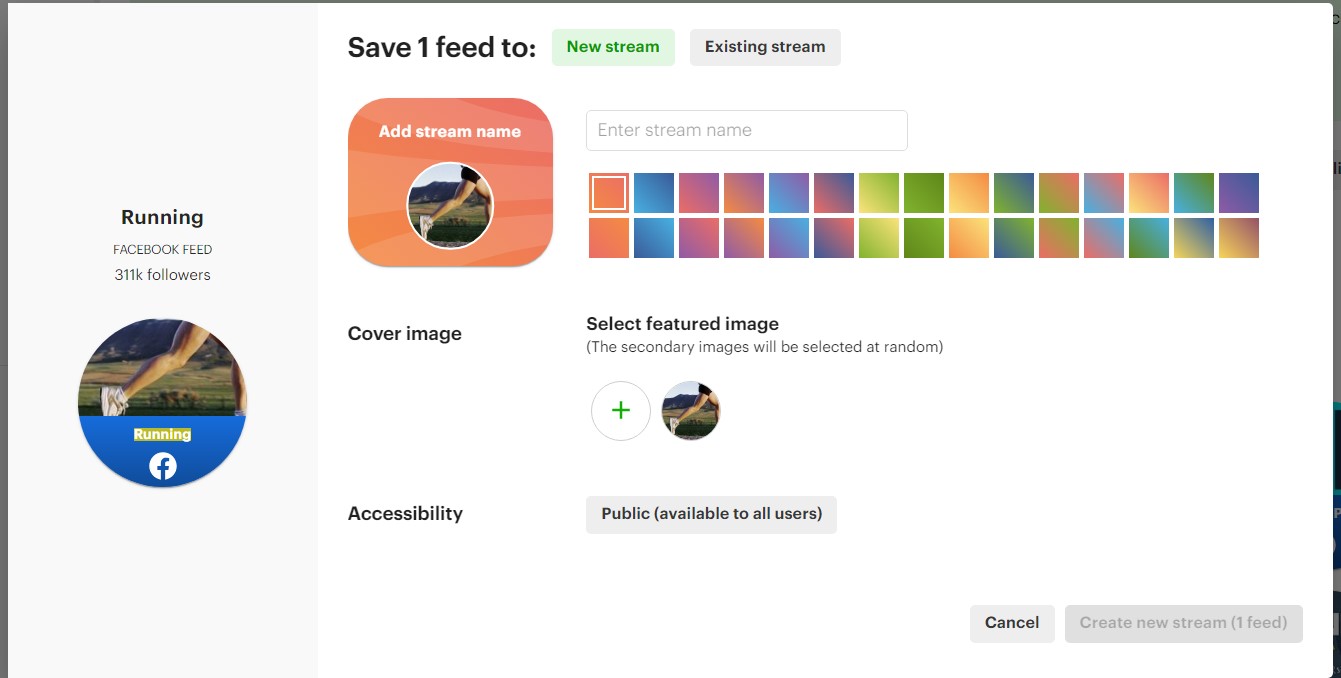
Add content to your content plan
Once you set up your posting plan and Content Streams, it’s time to start adding content to your plan.
Post Planner makes it easy to schedule LinkedIn content and to edit and optimize the content for each social channel.
Here’s how to do it:
- Pull up one of your Content Streams
- Select a piece of content (or multiple selections if you want to bulk add) by clicking the green “Add Content” button that appears when hovering over it.
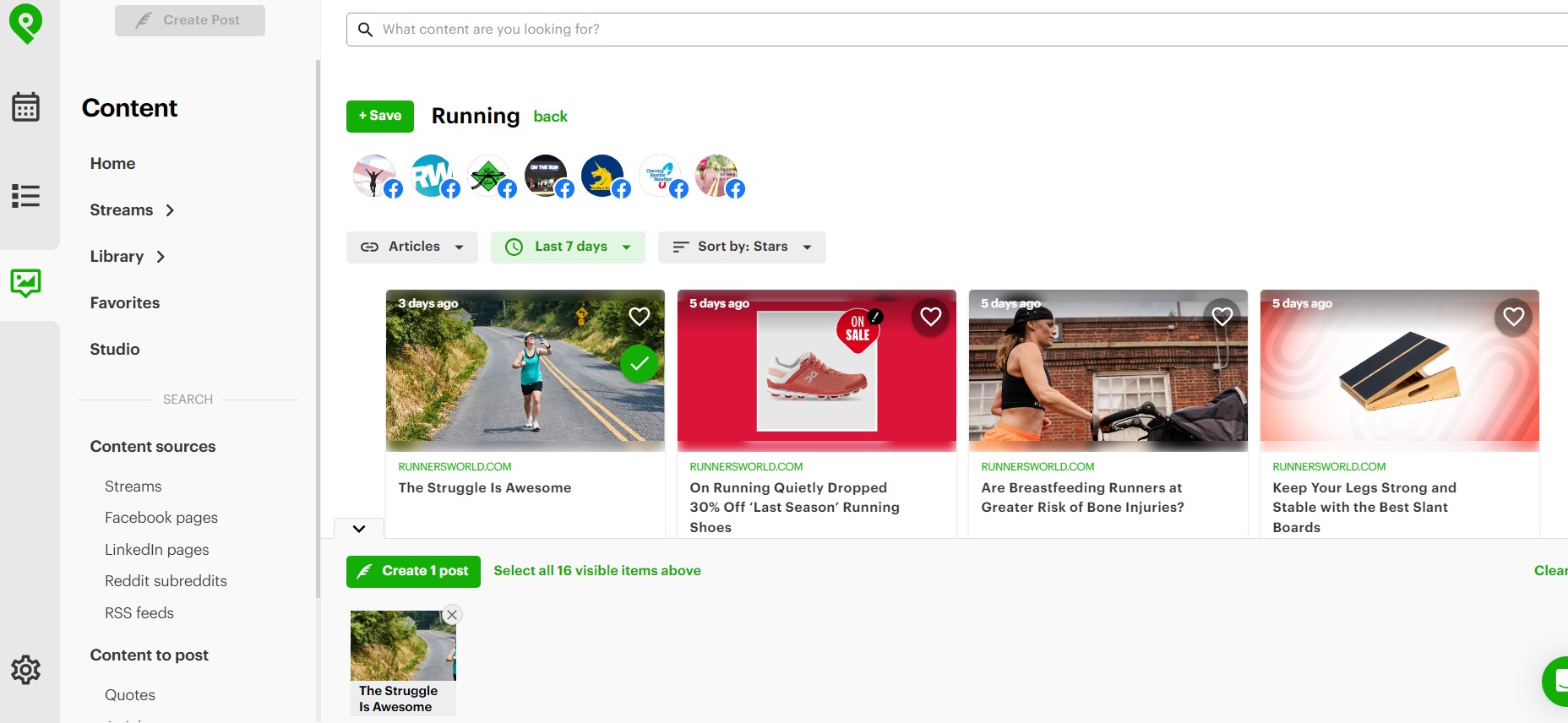
- Click “Create x Post/s” in the bottom bar shown above.
- Add the post to a bucket.
- Add your post content and optimize for the social networks you want to post on.
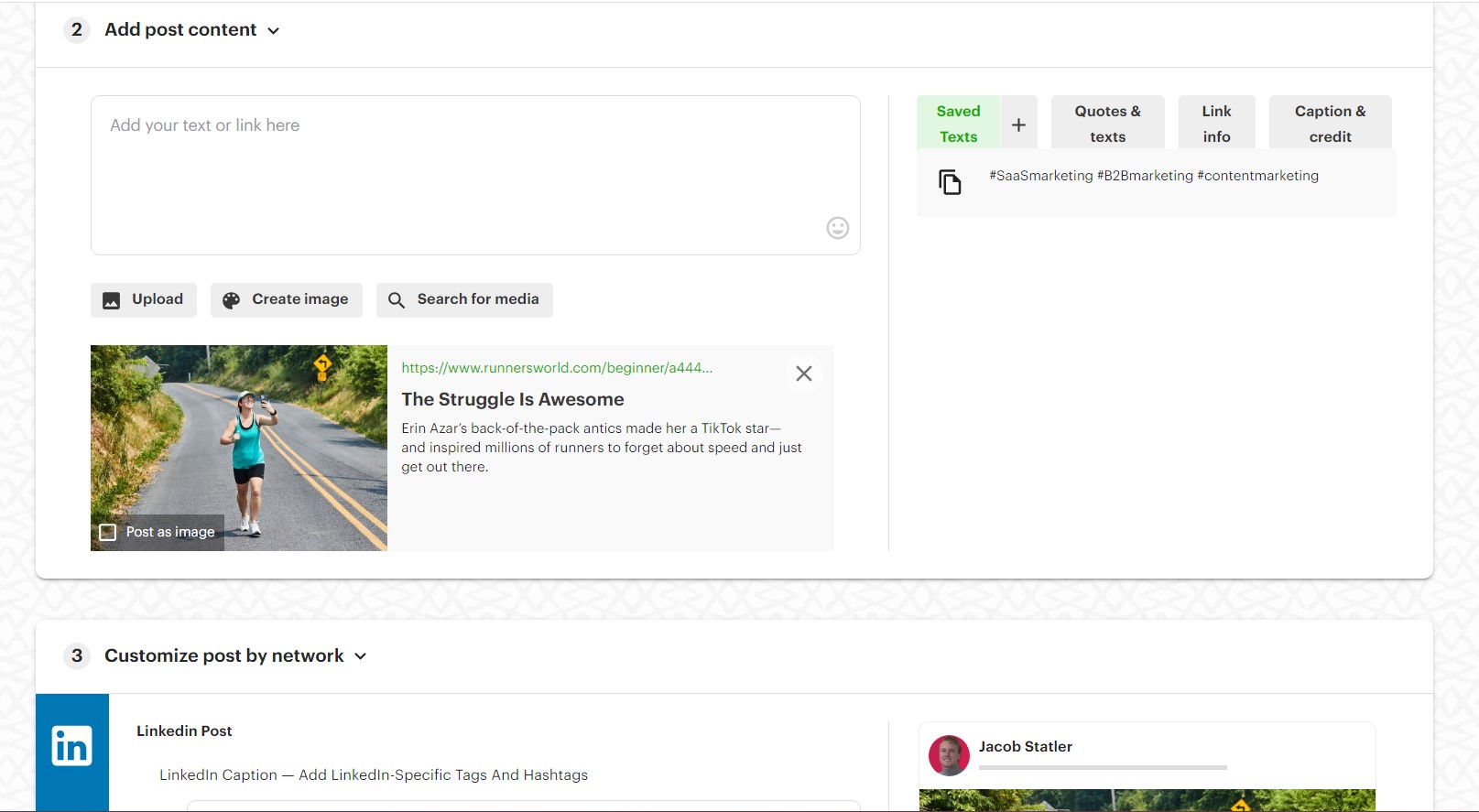
- Click “Add to queue.”
Repeat this process until you’ve filled up your content buckets with high-performing content, then watch as Post Planner automatically does the rest for you!
Ready to never run out of LinkedIn content?
Posting on LinkedIn can be a struggle, but don’t let that discourage you from showcasing your expertise.
Use the 17 sources above to help you quickly find compelling and engaging content, then use Post Planner to fully automate your content discovery and posting routine.
If you aren’t sure about Post Planner, I highly recommend trying a 7-day free trial to see how much it can help your business.
Happy posting!
[ad_2]
Source link



